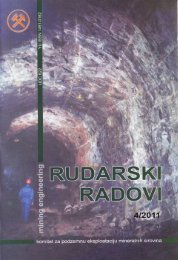Institut za rudarstvo i metalurgiju Bor
Institut za rudarstvo i metalurgiju Bor
Institut za rudarstvo i metalurgiju Bor
You also want an ePaper? Increase the reach of your titles
YUMPU automatically turns print PDFs into web optimized ePapers that Google loves.
activities, standards and habits of citizens,<br />
as well as the availability of energy resources<br />
and economic - energy conditions<br />
in the environment.<br />
Because of known circumstances in<br />
the past, Serbia is an example of the country,<br />
which is forced in the short term to<br />
harmonize not only energy development<br />
with the business economic development,<br />
but development of energy production<br />
sector with the sectors of energy consumption<br />
in order to achieve higher levels<br />
of socio-economic development. Oil<br />
shales, a few years ago, fell in the "unconventional"<br />
fossil fuels, and are of worldwide<br />
very little explored.<br />
Interest in oil shale and testing capabilities<br />
their use in our country dates back<br />
to before the I World War. After the War,<br />
research was done on several occasions,<br />
but not systematically, so it has not been<br />
carried out to the end.<br />
OIL SHALE IN SERBIA<br />
Site researches of oil shale in Serbia<br />
are very small. On the territory of Serbia<br />
oil shale sites were discovered in the following<br />
regions: Niš (the Aleksinac Basin,<br />
regions village Bovan and Prugovac,<br />
Bubušnica and Kosanica Basin), Zaječar<br />
(Timok zone between Knjaževac and Boljevac),<br />
South Moravic (the Vranje basin),<br />
Kraljevo (the Kruševac and Čačak-<br />
Kraljevo basin) and Podrinje - Kolubara<br />
(the Valjevo-Mionica basin).<br />
Today, only for the oil shale deposit<br />
around Aleksinac we can say it is better<br />
researched than others, thanks to investigative<br />
work that are undertaken for the<br />
production of coal, and thereby collected<br />
data on oil shale, on the basis of prospecting<br />
the drillholes. However, even these<br />
data are not sufficient for final evaluation<br />
and exploitation of geological reserves<br />
and their categori<strong>za</strong>tion.<br />
Reserves of oil shale in Serbia, according<br />
to estimates, are approximately 8-10<br />
billion tons, where the Aleksinac deposit<br />
is the most researched. Large reserves of<br />
coal in our country are not available due<br />
to the economic or technical reasons.<br />
Proven coal reserves that are not suitable<br />
for surface exploitation amounts exceeding<br />
500 million tons, and oil shale are only<br />
in the Aleksinac deposit, over 2 billion<br />
tons. [1]<br />
AIM OF RESEARCH<br />
For the currently known oil shale reserves<br />
in our country, put us to the task to<br />
determine what is the energy and raw potential,<br />
with which we can count on a certain<br />
level of current technological reserves,<br />
especially those to be expected in<br />
the future.<br />
In order to elaborate the possibility for<br />
industrial use of oil shales while bearing<br />
in mind the fact that our country has a<br />
considerable oil shale reserves, and that<br />
the coal reserves in our mining – the energy<br />
plant ''Kolubara" and "Kostolac" limited,<br />
made the possibility of simultaneous<br />
analysis of coal and oil shale from the<br />
Aleksinac basin.<br />
RESEARCH AREA<br />
The Aleksinac deposit of brown coal<br />
and oil shale overtakes the area between<br />
the River Morava and the South Moravica<br />
offers directly from the town of Aleksinac,<br />
in the direction of NNW, the length of 10<br />
km and covers the area of about 20 km 2 .<br />
It is one of the few in the world, where<br />
the layers of oil shale stored together with<br />
brown coal, in floor and overlie main coal<br />
layer. In 1883, the exploitation of brown<br />
coal was dominated by the combined,<br />
room-pillar mining methods. Depending<br />
on the mining-geological conditions of<br />
No 1, 2010. 48<br />
MINING ENGINEERING



